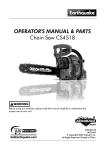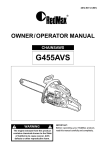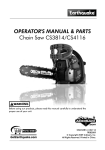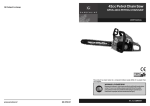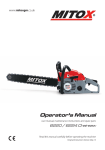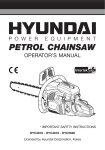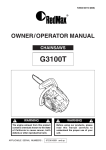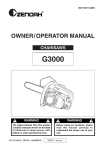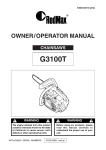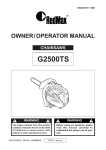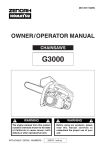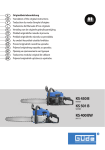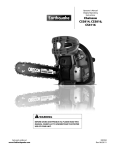Download Ardisam CS4518 Operator`s manual
Transcript
Operator's Manual & Parts Chain Saw CS4518 WARNING Before using our products, please read this manual carefully to understand the proper use of your unit. GetEarthquake.com OMCS4518 Rev12-23-09 © Copyright 2009 Ardisam, Inc. All Rights Reserved. Printed in China. Contents SAFETY FIRST Instructions contained in warnings within this manual marked with a WARNING symbol concern critical points which must be taken into consideration to prevent possible serious bodily injury, and for this reason you are requested to read all such instructions carefully and follow them without fail. WARNINGS IN THE MANUAL WARNING This mark indicates instructions which must be followed in order to prevent accidents which could lead to serious bodily injury or death. IMPORTANT This mark indicates instructions which must be followed, or it leads to mechanical failure, breakdown, or damage. NOTE This mark indicates hints or directions useful in the use of the product. Page 1. Parts location.............................................................................................. 4 2. Symbols on the machine.............................................................................. 5 3. For safe operation....................................................................................... 8 4. Installing guide bar and saw chain............................................................. 13 5. Fuel and chain oil..................................................................................... 15 6. Operation ............................................................................................... 17 7. Sawing .................................................................................................... 23 8. Maintenance............................................................................................. 26 9. Maintenance of Saw Chain and Guide Bar ................................................ 28 10. Storage.................................................................................................... 31 11. Troubleshooting guide............................................................................... 32 12. Specifications . ......................................................................................... 33 13. Warranty.................................................................................................. 34 Federal Emission Information Ardisam, Inc. warrants to the retail purchaser, that this small, off-road engine was designed, built and equipped to conform at the time of initial sale to all applicable regulations of the U.S. Environmental Protection Agency (EPA). Page Parts Location 1. Front hand guard and brake 2. Starter handle 3. Air filter cover 4. Choke knob 5. Throttle trigger lock-out 6. Rear handle 12 7. Throttle trigger 8. Engine switch 9. Fuel tank cap 10. Oil tank cap 11. Front handle 12. Saw chain 13. Guide bar 14. Primer Bulb 13 1 2 3 4 5 6 11 10 9 14 Page 8 7 Symbols on the Machine (1) Read operator's instruction book before operating this machine. (2) Appropriate ear, eye, and head protection must be worn. (3) Use the chain saw with two hands. (4) Warning! Danger of kickback. (5) Read, understand and follow all warnings. Page Symbols on the Machine For safe operation and maintenance, symbols are carved in relief on the machine. According to these indications, please be careful not to make any mistake. (a). The port to refuel the oil/gas mixture. Location: near the fuel cap (b). The port to refill the chain oil Location: near the oil cap (c). Operate the engine switch Flipping the switch to the "O" position immediately stops the engine. Location: rear at the left side of the rear handle (d). Operate the choke knob Pull out the choke knob, and the choke closes; push in the choke knob and the choke opens. Location: rear at the right side of the rear handle. (e). Adjust the oil pump If you turn the rod by screwdriver follow the arrow to the "MAX" position, the chain oil flows more, and if you turn to the "MIN" position, less. Location: Bottom of the power unit Page Symbols on the Machine Carb is set at factory. Special tools are required for carb adjustment and can only be performed by a qualified service center. Severe engine damage or personal injury may occur if proper procedures are not followed. (g). Shows the directions that the chain brake is released (white arrow) and activated (black arrow). Position: Front of the chain cover (h). Shows the direction of the saw chain installation. Position: Front of the chain cover NOTE Page For Safe Operation Before operating the product 1. Before using our products, please read this manual carefully to understand the proper use of your chainsaw. 2. Never operate a chainsaw when you are fatigued, ill, or upset, or under the influence of medication that may make you drowsy, or if you are under the influence of alcohol or drugs. 3. Operate the chainsaw only in well ventilated areas. Never start or run the engine inside a closed room or building. Exhaust fumes contain dangerous carbon monoxide. 4. Never cut in high wind, bad weather, when visibility is poor or in very high or low temperatures. Always check the tree for dead branches which could fall during the felling operation. 5. Use safety footwear, snug fitting clothing and eye, hearing and head protection devices. Page For Safe Operation 6. Always use caution when handling fuel. Wipe up all spills and then move the chain saw at least ten(10)feet (three(3) m) from the fueling point before starting the engine. 7. Eliminate all sources of sparks or flame (ie. smoking, open flames, or work that can cause sparks) in the areas where fuel is mixed, poured, or stored. Do not smoke while handling fuel or while operating the chain saw. 8. Do not allow other persons to be near the chain saw when starting the engine or cutting wood. Keep bystanders and animals out of the work area. Children, pets, and bystanders should be a minimum of 30 feet (10m) away when you start or operate the chain saw. 9. Never start cutting until you have a clear work area, secure footing, and planned retreat path from the falling tree. 10. Always hold the chain saw firmly with both hands when the engine is running. Use a firm grip with thumb and fingers encircling the chain saw handles. 11. Keep all parts of your body away from the saw chain when the engine is running. Before you start the engine, make sure the saw chain is not contacting anything. Page For Safe Operation 12. Always carry the chain saw with the engine stopped, the guide bar and saw chain to the rear, and the muffler away from your body. 13. Always inspect the chain saw before each use for worn, loose, or changed parts. Never operate a chain saw that is damaged, improperly adjusted, or is not completely and securely assembled. Be sure that the saw chain stops moving when the throttle control trigger is released. 14. All chain saw service, other than the items listed in the Operator’s Manual, should be performed by an authorized repair center. (e.g., if improper tools are used to remove the flywheel, or if an improper tool is used to hold the flywheel in order to remove the clutch, structural damage to the flywheel could occur which could subsequently cause the flywheel to disintegrate). 15. Always shut off the engine before setting it down. 16. Use extreme caution when cutting small size brush and saplings because slender material may catch the saw chain and be whipped toward you or pull you off balance. 17. When cutting a limb that is under tension, be alert for spring back so that you will not be struck when the tension in the wood fibers is released. 18. Keep the handles dry, clean and free of oil or fuel mixture. Page 10 For Safe Operation 19. Guard against kickback. Kickback is the upward motion of the guide bar which occurs when the saw chain at the nose of the guide bar contacts an object. Kickback can lead to dangerous loss of control of the chain saw. KICKBACK SAFETY PRECAUTIONS FOR CHAIN SAW USERS WARNING Kickback may occur when the nose or tip of the guide bar touches an object, or when the wood closes in and pinches the saw chain in the cut. Tip contact in some cases may cause a lightning fast reverse reaction, kicking the guide bar up and back towards the operator. Pinching the saw chain along the top of the guide bar may push the guide bar rapidly back towards the operator. Either of these reactions may cause you to lose control of the saw which could result in serious personal injury. Do not rely exclusively on the safety devices built into your saw. As a chain saw user you should take several steps to keep cutting jobs free from accident or injury. (1) With a basic understanding of kickback you can reduce or eliminate the element of surprise. Sudden surprise contributes to accidents. Page 11 For Safe Operation (2) Keep a good grip on the saw with both hands, the right hand on the rear handle, and the left hand on the front handle, when the engine is running. Use a firm grip with thumbs and fingers encircling the chain saw handles. A firm grip will help you reduce kickback and maintain control of the saw. Don’t let go. (3) Make certain that the area in which you’re cutting is free from obstructions. Do not let the nose of the guide bar contact a log, branch, or any other obstruction which could be hit while you are operating the saw. (4) Cut at high engine speeds. (5) Do not overreach or cut above shoulder height. (7) Only use replacement bars and chains specified by the manufacturer or the equivalent. Page 12 (6) Follow manufacturers sharpening and maintenance instructions for saw chain. Installing Guide Bar / Chain 1 A standard saw unit package contains the items as shown below.: 4 (1) Power unit 5 (2) Guide bar 2 (3) Saw chain 3 (4) Plug wrench (5) Screwdriver for carburetor adjustment Open the box and install the guide bar and the saw chain on the power unit as follows. The saw chain has very sharp edges. Use protective gloves for safety. 1. Pull the guard towards the front handle to check that the chain brake is not on. 2. Loosen a nut and remove the chain cover. Then, remove bar spacer used for shipping (see photo A). 3. Wrap the chain to the sprocket and, while fitting the saw chain around the guide bar, mount the guide bar to the power unit. Adjust the position of chain tensioner nut. (7) Hole (8) Chain tensioner nut. (9) Clutch cover WARNING photo A: bar spacer to remove Page 13 Installing Guide Bar / Chain NOTE Pay attention to the correct direction of the saw chain. 1)Moving direction 4. Mount the guide bar then fit the saw chain around the bar and sprocket. 5. Fit the chain tensioner nut into the lower hole of the guide bar, then install the chain cover, and fasten the mounting nut to finger tightness. 6. While holding up the tip of the bar, adjust the chain tension by turning the tensioner screw until the tie straps just touch the bottom side of the bar rail. 7. Tighten the nuts securely with the bar tip held up 10 ft lbs (100130 inch lbs). Then check the chain for smooth rotation and proper tension while moving it by hand. If necessary, readjust with the chain cover loose. 8. Tighten the tensioner screw. (1) Loosen (2) Tighten (3) Chain tension adjusting screw IMPORTANT It is very important to maintain the proper chain tension. Rapid wear of the guide bar or the chain coming off easily can be caused by improper tension. Especially when using a new chain, take good care of it since it should expand when first used. Page 14 Fuel and Chain Oil Fuel The engines are lubricated by Viper Engine Oil specially formulated for air-cooled 2-cycle gasoline engine use. If oil is not available, use an antioxidant added quality oil expressly labeled for air-cooled 2-cycle chain saw engine use. RECOMMENDED MIXING RATIO GASOLINE 50 : OIL 1 These engines are certified to operate on unleaded gasoline. See chart for mixing. GAS OIL RATIO 1 gallon 2.6 ounces 50:1 2.5 gallons 6.4 ounces 50:1 WARNING The fuel is highly flammable. Do not smoke or bring any flame or sparks near fuel. IMPORTANT 1. DO NOT USE FUEL WITHOUT AN OIL MIXTURE (RAW GASOLINE) It will cause severe damage to the engine inner parts very quickly and void warranty. 2. DO NOT USE OIL MEANT FOR 4-CYCLE ENGINE USE or WATER COOLED 2-CYCLE ENGINE USE It can cause spark plug fouling, exhaust port blocking, or piston ring sticking and void warranty. HOW TO MIX FUEL 1. Measure out the quantities of gasoline and oil to be mixed. 2. Put some of the gasoline into a clean, approved fuel container. 3. Pour in all of the oil and agitate well. Page 15 Fuel and Chain Oil 4. Pour in the rest of gasoline and agitate again for at least one minute. 5. Mark the container clearly on the outside of the container to avoid mixing up with gasoline or other containers. CHAIN OIL Use special chainsaw oil all year round. Recommended for winter or summer use. Page 16 NOTE Do not use waste or regenerated oil that can cause damage to the oil pump. Operation WARNING Before you start the engine, make sure the saw chain is not contacting anything. STARTING ENGINE 1. Untwist and remove the fuel cap. Rest the cap on a dustless place.. 2. Put fuel into the fuel tank to 80% of the full capacity. 3. Fasten the fuel cap securely and wipe up any fuel spillage around the unit. 4. Put the switch to the "I" position. 5. Continuously push the priming bulb until fuel comes in the bulb. (1) Oil (2) Fuel (3) Engine switch (4) Choke knob 6. Pull out the choke knob. The choke will close and the throttle lever will then be set in the starting position. NOTE When restarting immediately after stopping the engine. Set choke in the open position NOTE Once the choke knob has been pulled out, it will not return to the operating position fully even if you press down on it with your finger. When you wish to return the choke knob to the fully open position, squeeze the throttle lever instead. 7. While holding the saw unit securely on the ground, pull the starter rope vigorously. Page 17 Operation 8. When firing occurs, push in the choke knob and pull the starter again to start the engine. 9. Allow the engine to warm up with the throttle lever pulled slightly. IMPORTANT The oil tank should become nearly empty by the time fuel is used up. Be sure to refill the oil tank every time when refueling the saw. ADJUSTING CARBURETOR The carburetor on your unit has been factory adjusted. NOTE Carb is set at factory. Special tools are required for carb adjustment and can only be performed by a qualified service center. Severe engine damage or personal injury may occur if proper procedures are not followed. Page 18 Operation CHAIN BRAKE The chain brake is a device which stops the chain instantaneously if the chain saw recoils due to kickback. Normally, the brake is activated automatically by inertial force. It can also be activated manually by pushing the brake lever (Front handle guard) down toward the front. When the brake operates, a white cone (5) pops up from the base of the brake lever. (1) Front handle (2) Release (3) Brake (4) Front handle guard (5) White cone (5) Page 19 Operation To release brake, pull up the front handle guard toward the front handle till “click” sound is heard. WARNING When the brake operates, release the throttle lever to slow down the engine speed. Continuous operation with the brake engaged will generate heat from the clutch and may cause damage. Be sure to confirm brake operation on the daily inspection. How to confirm: 1) Turn off the engine. 2) Holding the chain saw horizontally, release your hand from the front handle, hit the tip of the guide bar to a stump or a piece of wood, and confirm brake operation. Operating level varies by bar size. In case the brake is not effective, contact our authorized service center. Stopping engine 1. Release the throttle lever to allow the engine to idle for a few minutes. 2. Move the switch lever downward. (1) Engine switch Page 20 Sawing WARNING Before proceeding to your job, read "For Safe Operation" section It is recommended to first practice sawing easy logs. This also helps you get accustomed to your chainsaw. Always follow the safety regulations. The chain saw must only be used for cutting wood. It is forbidden to cut other types of material. Vibrations and kickback vary with different materials and the requirements of the safety regulations would not be respected. Do not use the chain saw as a lever for lifting, moving or splitting objects. Do not lock it over fixed stands. DO NOT hitch tools or applications to the P.t.o. that are not specified by the manufacturer. It is not necessary to force the saw into the cut. Apply only light pressure while running the engine at full throttle. Racing the engine with the chain seized in a cutaway can damage the clutch system. When the saw chain is caught in the cut, do not attempt to pull it out by force, but use a wedge or a lever to open the cut. Guard against kickback This saw is also equipped with a chain brake that will stop the chain in the event of kickback if operating properly. You must check the chain brake operation before each usage by running the saw at full throttle for 1 or 2 seconds and pushing the front hand guard forward. The chain should stop immediately with the engine at full speed. If the chain is slow to stop or does no stop then replace the brake band and clutch drum before use. It is extremely important that the chain brake be checked for proper operation before each use and that the chain be sharp in order to maintain the kickback safety level of this saw. Removal of the safety devices, inadequate maintenance, or incorrect replacement of the bar or chain may increase the risk of serious personal injury due to kickback. Page 21 Sawing Page 22 Felling a Tree 1. Decide the felling direction considering the wind, Iean of the tree, location of heavy branches, ease of job after felling, and other factors. 2. While clearing the area around the tree, arrange a good foothold and retreat path. 3. Make a notch cut one-third of the way into the tree on the felling side. 4. Make a felling cut from the opposite side of the notch and at a level slightly higher than the bottom of the notch. WARNING When you fell a tree, be sure to warn your neighboring workers of the danger. (1) Notch cut (2) Felling cut (3) Felling direction Sawing LOGGING AND LIMBING WARNING 1. Always ensure your foothold as well as stability of the tree. 2. Be alert to the rolling over of a cut log. 3. Read the instructions in “For Safe Operation” to avoid kickback of the saw. Before starting work, check the direction of bending force inside the log to be cut. Always finish cutting from the opposite side of bending direction to prevent the guide bar from being caught in the cutaway. Cutting an unpillowed log Saw down halfway, then roll the log over and cut from the opposite side. Cutting a pillowed log In the area A in the picture right above, saw up from the bottom one-third and finish by sawing down from the top. In the area B, saw down from the top one-third and finish by sawing up from the bottom. Limbing a felled tree First check which way the limb is bent. Then make a shallow cut into the compressed side to prevent the limb from being torn. Cut through from the tensed side. WARNING Be alert to the spring back of a cut limb. Page 23 Sawing Page 24 Pruning Cut up from the bottom, finish down from the top. WARNING 1. Do not use an unstable foothold or a stepladder. 2. Do not overreach. 3. Do not cut above shoulder height. 4. Always use both hands to grip the saw. Maintenance Good maintenance is essential for safe, economical, and trouble-free operation. It will also help reduce air pollution. To help you properly care for your chainsaw, the following pages include simple maintenance procedures using basic hand tools. Other service tasks that are more difficult, or require special tools, are best handled by professionals and are normally performed by a technician or other qualified mechanic. Maintenance, replacement or repair of the emissions control devices and systems may be performed by any non-road engine repair establishment or individuals. However, items must be serviced by an authorized dealer to obtain "no charge" emissions control service. The maintenance schedule applies to normal operating conditions. If you operate your engine under unusual conditions, such as sustained high-load or high-temperature operation, or use in unusually wet or dusty conditions, consult your servicing dealer for recommendations applicable to your individual needs and use. WARNING Before cleaning, inspecting or repairing your unit, make sure that engine has stopped and is cool. Disconnect the spark plug to prevent accidental starting. Maintenance after each use 1. Air filter Dust on the cleaner surface can be removed by tapping a corner of the cleaner against a hard surface. To clean dirt in the meshes, split the cleaner into halves and brush in gasoline. When using compressed air, blow from the inside. To assemble the cleaner halves, press the rim until it clicks. 2. Oiling port Dismount the guide bar and check the oiling port for clogging. (1) Oiling port 3. Guide bar When the guide bar is dismounted, remove sawdust in the bar groove and the oiling port. Grease the nose sprocket from the feeding port on the tip of the bar. Page 25 Maintenance (2) Grease port (3) Sprocket 4. Others Check for fuel leakage and loose fastenings and damage to major parts, especially handle joints and guide bar mounting. If any defects are found, make sure to have them repaired before operating again. Periodical service points 1. Cylinder fins Dust clogging between the cylinder fins will cause overheating of the engine. Periodically check and clean the cylinder fins after removing the air cleaner and the cylinder cover. When installing the cylinder cover, make sure that switch wires and grommets are positioned correctly in place. 2. Fuel filter (a) Using a wire hook, take out the filter from the filler port. (1) Fuel filter (b) Disassemble the filter and wash with gasoline, or replace with a new one if needed. Page 26 IMPORTANT • After removing the filter, use a pinch to hold the end of the suction pipe. • When assembling the filter, take care not to allow filter fibers or dust inside the suction pipe. Maintenance 3. Oil tank With a wire hook, take out the oil filter through the filler port and clean in gasoline. When putting the filter back into the tank, make sure that it comes to the front right corner. Also clean out dirt in the tank. (2) Oil filter 4. Spark plug Clean the electrodes with a wire brush and reset the gap to 0.65mm as necessary. Spark plug type::Champion CJ7Y or equivalent 5. Sprocket Check for cracks and for excessive wear interfering with the chain drive. If the wearing is found obviously, replace it with a new one. Never fit a new chain on a worn sprocket, or a worn chain on a new sprocket. Always replace cutting system components at the same time (i.e. bar, chain and sprocket). (1) Needle bearing (2) Sprocket (3) Clutch drum (4) Washer (5) Clutch block 6. Front and Rear dampers Replace if part is peeled or crack is observed on the rubber part. Page 27 Maintenance of Chain / Bar Saw chain WARNING It is very important for smooth and safe operation to keep the cutters always sharp. Your cutters need to be sharpened when: • Sawdust becomes powder-like. • You need extra force to saw in. • The cut way does not go straight. • Vibration increases. • Fuel consumption increases. Cutter setting standards: WARNING Be sure to wear safety gloves. Before filing: • Make sure the saw chain is held securely. • Make sure the engine is stopped. • Use a round file of proper size for your chain. Chain type: Oregon 91P/Carlton N1C File size: 4.0mm (0.157 inches) Place your file on the cutter and push straight forward. Keep the file position as illustrated. Oregon replacement chain S62 Page 28 Maintenance of Chain / Bar After every cutter has been set, check the depth of the rake by using a depth gauge to measure the height difference. File it to the proper level as illustrated. WARNING Be sure to round off the front edge to reduce the chance of kickback or tie-strap breakage. (1) Appropriate gauge checker (2) Make the shoulder round 3) Depth gauge standard Make sure every cutter has the same length and edge angles as shown below. (4) Cutting length (5) Filling angle (6) Side plate angle (7) Top plate cutting angle Page 29 Maintenance of Chain / Bar WARNING This saw is equipped with the following low kickback bar/chain combination: Guide bar: Oregon180SDEA095 Saw chain: 3/8 low profile reduced kickback chain 62 drive links Oregon S62 For replacement use only above bars and chains Engine Maintenance Schedule Every 8 hours (daily) Maintenance Item Clean Engine and Check Bolts & Nut Every 20 hours or seasonally X Air Filter Check (See Air Filter section) Clean * X Replace X Check/Adjust X Spark Plug (Gap .028”) X (See Spark Plug section) Replace * Service more frequently under dusty conditions Page 30 Each Year X X Storage 1. Empty the fuel tank and run the engine out of fuel. 2. Empty the oil tank. 3. Clean the entire unit. 4. Store the unit in a dry place out of the reach of children. Page 31 Parts Explosions 1 2 6 5 3 4 Page 32 Parts Explosions 12 7 8 9 19 14 13 10 11 15 KEY Part # Description 1 845100 Right cover assembly Qty. 1 2 845101 Air filter cover kit 1 3 845104 starter assembly 1 4 845105 oil pump 1 5 845106 clutch assembly kit 1 6 845109 clutch shell 1 7 845110 fuel cap kit 1 8 845115 fuel tube 1 9 845116 gas filter components 1 10 845118 primer bulb 1 11 845119 oil cap Kit 1 12 845117 air filter 1 13 845103 Scavenge tube 1 14 845102 pump tube 1 15 845107 carburetor 1 16 838119 BUCKING SPIKE, CHAINSAW 1 17 838120 BUCKING SPIKE, CHAINSAW MOUNT SCREW 2 18 845108 COIL ASSY. (NOT SHOWN) 1 19 845111 TRIGGER ASSEMBLY KIT 1 Page 33 Troubleshooting Guide Problem Cause Remedy Starting failure Check fuel for water or substandard mixture Replace with proper fuel Remove and dry the spark plug Pull the starter again with no choke Replace spark plug with a new plug Lack of power / Poor acceleration / Rough idling Oil does not come out Check for water or substandard mixture Replace with proper fuel Check air filter and fuel filter for clogging Clean Check carburetor for inadequate adjustment Have an authorized service center adjust the carburetor. Check oil for substandard quality Replace Check oil passage and ports for clogging Clean If the unit seems to need further service, please consult with an authorized service shop in your area. Page 34 Specifications Power unit: Displacement . . . . . . . . . . . . . . . . . . . . . . . . . . . . . . . . . . . . . . . . . . . . . . . . . 45.02cc Maximum engine power . . . . . . . . . . . . . . . . . . . . . . . . . . . . . . . . . . . . . . . . . . 1.8kW Fuel . . . . . . . . . . . . . . . . . . . . . . . . . Mixture (Unleaded Gasoline 50 : two-cycle oil 1) Fuel tank capacity . . . . . . . . . . . . . . . . . . . . . . . . . . . . . . . . . . . . . . . . . . . . . . 550ml Chain oil . . . . . . . . . . . . . . . . . . . . . . . . . . . . . . . . . . . . . . Seasonal bar and chain oil Oil tank capacity . . . . . . . . . . . . . . . . . . . . . . . . . . . . . . . . . . . . . . . . . . . . . . . 260ml Carburetor . . . . . . . . . . . . . . . . . . . . . . . . . . . . . . . . . . . . . . . . . . . . Diaphragm type Fuel consumption at maximum engine power . . . . . . . . . . . . . . . . . . . . . . 560g/kw•h Idling speed . . . . . . . . . . . . . . . . . . . . . . . . . . . . . . . . . 3000 rpm max / rpm +/- 150 Maximum speed with cutting attachment . . . . . . . . . . . . . . . . . . . . . . . . . . 11000r/min Ignition system . . . . . . . . . . . . . . . . . . . . . . . . . . . . C.D.I. with timing advance function Spark plug . . . . . . . . . . . . . . . . . . . . . . . . . . . . . . . . . . Champion CJ7Y or equivalent Oil feeding system . . . . . . . . . . . . . . . . . . . . . . Mechanical plunger pump with adjuster Sprocket Teeth x Pitch . . . . . . . . . . . . . . . . . . . . . . . . . . . . . . . . . . . . . . . . 7T×0.375in Dimensions (L x W x H) . . . . . . . . . . . . . . . . . . . . . . . . . . . . . . . 425×240×288(mm) Dry weight (without guide bar and chain, empty tanks): . . . . . . . . . . . . . . . . . 12.78 lbs Cutting head: Guide bar Type: Oregon® 180SDEA095 . . . . . . . . . . . . . . . . . . . . . . . . . . . . . . . . . . Sprocket nose Size: . . . . . . . . . . . . . . . . . . . . . . . . . . . . . . . . . . . . . . . . . . . . . . . . . . . . . . . 18in Cutting length: . . . . . . . . . . . . . . . . . . . . . . . . . . . . . . . . . . . . . . . . . . . . . . . 18in Saw chain Type: . . . . . . . . . . . . . . . . . . . . . . . . . . . . . . . . . . . . . . . . . . . . . . . Oregon® S62 Pitch: . . . . . . . . . . . . . . . . . . . . . . . . . . . . . . . . . . . . . . . . . . . . . . . . . . . . . 3/8in Gauge: . . . . . . . . . . . . . . . . . . . . . . . . . . . . . . . . . . . . . . . . . . . . . . . . . 0.050in Specifications are subject to change without notice. Page 35 Warranty Terms and Conditions Product Warranty: 1-Year Limited Warranty Ardisam, Inc., a manufacturing company, warrants this Earthquake® Chainsaw to be free from defects in the material or workmanship for a period of one year from the date of purchase. During the one year warranty of this product, Ardisam will furnish 100% parts and labor to correct any defect caused by faulty material or workmanship. Any unit used in a commercial application is covered for a period of 90 days after purchase. This warranty applies to the original owner with a proof of purchase and is not transferable. This guarantee is void unless the warranty card is properly filled out and received by Ardisam, Inc., within 30 days of purchase or go to www.GetEarthquake.com for online registration. For replacement parts, phone 800-345-6007 or go online to www.GetEarthquake.com. Engine Warranty: 2-Year Limited Warranty Ardisam, Inc., a manufacturing company warrants its Viper Engines under a two-year limited warranty to be free from defects in materials and workmanship for the service life of the product not to exceed twenty four consecutive months from the date of purchase for consumer applications. As an Ardisam Viper small engine owner, you are responsible for executing proper maintenance listed in your Operating and Maintenance Instructions. The warranty period begins on the date of purchase by the first retail consumer or commercial end user, and continues for the period of time stated above. *These warranties apply only to products which have not been subjected to negligent use, misuse, alteration, accident, unauthorized parts, failure to use proper fuel and oil, or if repairs have been performed at non-authorized service centers. These warranties supersede all other warranties either expressed or implied and all other obligations or liabilities on our part. Ardisam, does not assume, and does not authorize any other person to assume for us, any liability in connection with the sale of our products. To be at "No Charge," warranty work must be sent directly to Ardisam, Inc. or one of our authorized service centers and performed by them. To obtain warranty service and/or replacement instructions, contact our customer service department at 800-345-6007 Monday through Friday from 8 a.m. to 5 p.m. or visit www.ardisam.com. If you choose to ship your product to Ardisam for warranty repair, you must first have prior approval from Ardisam by calling our customer service department at 800-345-6007 for a return material authorization number (RMA#). Under these circumstances, all items must be shipped prepaid. Ardisam will at no charge, repair or replace, at their discretion, any defective part which falls under the conditions stated above. Ardisam retains the right to change models, specifications and price without notice. Page 36 Warranty Explanation of Emissions Control Warranty Provisions These chainsaws are designed, built and equipped to meet all EPA requirements. Ardisam warrants that it is free from defects in material and workmanship that could cause failure to the warranted part; and that it is identical in all material respects to the engine described in the manufacturer's application for certification. When a warrantable condition exists, Viper will repair your engine at no cost to you, including parts and labor. The engine emissions label will indicate certification information. If the purchaser is in need of a warrantable repair and is not within 100 miles distance from an Ardisam authorized repair center, Ardisam will pay for shipping costs to and from an authorized Ardisam repair center. Listed below are the parts covered by the emission control systems warranty. Some parts listed below may require scheduled maintenance and are warranted up to the first scheduled replacement point for that part. Coverage under this warranty includes only the parts listed below (the emission and evaporation control systems) if so equipped: • Air Filter Assembly (only to the first scheduled replacement point) • Fuel Filter (only to the first scheduled replacement point) • Carburetor • Fuel Lines, Fuel Line Fittings and Clamps • Fuel Metering Valve (if equipped) • Evaporative System (if equipped) - Canister (if equipped) - Canister filter (if equipped) - Vapor hose (if equipped) - Orifice connector (if equipped) - Fuel tank - Fuel cap - Primer bulb canister (if equipped) • Spark Plugs • Magneto Ignition System • Muffler Assembly LIMITATIONS The Emission Control Systems Warranty shall not cover any of the following: a) Repair or replacement required because of misuse or neglect, improper maintenance, repairs improperly performed or replacements not conforming to Ardisam, Inc. specifications that adversely affect performance and/or durability and alterations or modifications not recommended or approved in writing by Ardisam, Inc. Page 37 Warranty b) Replacement of parts and other services and adjustments necessary for required maintenance at or after the first scheduled replacement point; c)Consequential damages such as loss of time, inconvenience, loss of use of the engine or equipment, etc. d) Diagnosis and inspection fees that do not result in eligible warranty service being performed; and e)Any add-on or modified part, or malfunction of authorized parts due to the use of add-on or modified parts. These items will be covered for a period of two years from the date of the original purchase. Viper warrants that: the components are designed, built and equipped so as to conform with all applicable regulations adopted by the EPA; that they are free from defects in material and workmanship that could cause failure to the engine or other; and that the components used are identical in all material respects to the engine described in the manufacturer's application for certification. The warranty period begins on the date the engine is originally purchased. MAINTENANCE AND REPAIR REQUIREMENTS The owner is responsible for the proper use and maintenance of the engine. Ardisam, Inc. recommends that all receipts and records covering the performance of regular maintenance be retained in case questions arise. If the engine is resold during the warranty period, the maintenance records should be transferred to each subsequent owner. Ardisam, Inc. reserves the right to deny warranty coverage if the engine has not been properly maintained; however, Ardisam, Inc. may not deny warranty repairs solely because of the lack of repair maintenance or failure to keep maintenance records. Normal maintenance replacement or repair of emission control devices and systems may be performed by any repair establishment or individuals; however, warranty repairs must be performed by an Ardisam authorized service center. Any replacement parts or service that is equivalent in performance and durability may be used in non-warranty maintenance or repairs, and shall not reduce the warranty obligations of the engine manufacturer. The warranty on emissions-related parts is as follows: • Any warranted part that is not scheduled for replacement as required maintenance in the owner's manual supplied, is warranted for the warranty period stated above. If any such part fails during the period of warranty coverage, that part will be repaired or replaced at no charge to the owner. Any such part repaired or replaced under the warranty will be warranted for the remaining warranty period. • Any warranted part that is scheduled only for regular inspection in the owner's manual supplied, is warranted for the warranty period. Any such part repaired or replaced under warranty will be warranted for the remaining warranty period. Page 38 Notes • Any warranted part that is scheduled for replacement as required maintenance in the owner's manual supplied, is warranted for the period of time prior to the first scheduled replacement point for that part. If the part fails prior to the first scheduled replacement, the part will be repaired or replaced at no charge to the owner. Any such part repaired or replaced under warranty will be warranted for the remainder of the period prior to the first scheduled replacement point for the part. • Add on or modified parts that are not exempted by the Air Resources Board may not be used. The use of any nonexempted add on or modified parts by the owner will be grounds for disallowing a warranty claim. The manufacturer will not be liable to warrant failures of warranted parts caused by the use of a nonexempted add on or modified part. Page 39 Visit www.ardisam.com and discover more innovations that will benefit you throughout the year. Earthquake, Division of Ardisam, Inc. • 1160 Eighth Avenue; P.O. Box 666 Cumberland, Wisconsin 54829 800-345-6007 · Fax (715) 822-4180 • E-mail: [email protected] GetEarthquake.com Page 40








































